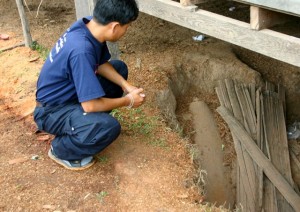Sometimes we can quickly destroy UXO. But bombs found within a village take extensive planning.

A 750-pound bomb will instantly turn nearby houses into flying debris which will, in turn, destroy other village structures
In an effort to help our supporters understand why our thirteen-person team could not immediately “render safe” the 750 bomb that we identified in a village, I’ve compiled a list of the steps that staff must follow when assisting a village that is threatened by such a destructive device.
Ten years ago I was a very minor member of a team that rendered safe a similar bomb, found in a similar setting. That bomb was safely destroyed in a group effort that involved more than fifty individuals: technicians, deminers, police officers and Lao soldiers.
You don’t tackle ordnance of any size (big bomb, cluster bomb, rocket, mortar, hand grenade) unless you are certain that have the staff, the skill, and the resources to do more good than harm. And then, in the words of Paul Stanford, my mentor: “You have to get it right the first time—every time!”
Critical steps:
1. Carefully excavate the bomb.
2. Clean the bomb sufficiently to expose markings that provide information about its fusing and content.
3. Determine the five “W’s”:
What is it? Where is it? When was it put there? Why is it there? Whether anyone has touched it?
4. Search the area for additional UXO.
5. Create a map of the area indicating notable structures and features; establish the relationship of the bomb to its surroundings.
6. Photograph structures in the village to establish “before demolition” condition.
7. Discuss options with other EOD (Explosive Ordnance Disposal) specialists.
8. Identify neighboring utilities: drop overhead electric lines; purge gas lines.
9. Sandbag the site, as appropriate.
10. Inform local authorities of intent to render the bomb safe.
11. Inform, discuss and plan with local police, district military and other authorities. Seek their assistance.
12. If need be: inform provincial authorities.
13. Seek advice and consent from village chief, monks, elders and other village leaders when determining course of action and selecting work dates.
14. Determine the most appropriate window of opportunity.
15. Advertise the upcoming event.
16. Compile list of residents who will need special assistance on the day of the demolition: the elderly, the infirmed, villagers who are cognitively disabled, deaf who may be wearing Hearing Aids, blind, linguistically diverse, etc.
Immediately prior to demolition:
17. Inspect and test firing cable, exploder, and all electrical connections.
18. Monitor weather conditions relative to the comfort of evacuees and the possibility of lightning triggering the exposed ordnance.
19. Remove to safety the entire contents of adjacent houses and other structures.
20. Remove to safety the “selected” contents of more distant houses and structures. (i.e. valuable or treasured possessions).
21. Identify and publicize the sites to which residents will be evacuated. Consider both safety and comfort: toilets, drinking water, shelter from sun, wind, rain.
22. Collect explosive material and detonators from secure storage.
23. Post sentries and take control of roads and walking trails.
24. Have sentries with bullhorns walk the villages and inform residents of the need to evacuate.
25. Have staff visit the homes of villagers who have been identified with special needs: elderly, infirmed, etc.
26. Monitor and assist with the removal of livestock.
27. Maintain constant radio contact with the ring of sentries who surround the now-empty village. (Have sentries confer with their GPS units to assure correct location).
28. When the village has been evacuated and residents and their possessions are as secure as practicable, proceed with the demolition. You can look at here if you want to determine the machinery required for the demolition.
